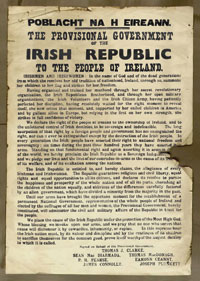1 April 2010 Edition
Remembering the Past: The Proclamation

BY MÍCHEÁL
Mac DONNCHA
The 1916 Proclamation stands as probably the single most important document in Irish history and one of the most significant documents in the history of progressive movements all over the world. In choosing to set out not only their motivation for an armed revolt against British rule but also the rights on which the Irish Republic would be based, the authors of the Proclamation left a lasting legacy.
The Proclamation declared the right of the people of Ireland to the ownership of Ireland and “standing on that fundamental right” proclaimed the Irish Republic as a Sovereign Independent State. It guaranteed religious and civil liberty, equal rights and equal opportunities and resolved to “pursue the happiness and prosperity of the whole nation and of all its parts, cherishing all the children of the nation equally”. It stated that it was “oblivious of the differences carefully fostered by an alien government, which have divided a minority from the majority in the past”. This was recognition of the alienation of unionists from the nationalist majority and a guarantee of their rights in a free Ireland.
It is clear that the two most important authors of the Proclamation were Pádraic Pearse and James Connolly. The declaration of rights contained in the Proclamation echoes the writings of Pearse, especially his pamphlet The Sovereign People, which, in turn, was influenced by the writings of James Connolly.
The signatories were the members of the Military Council which had planned the Rising and the honour of being the first to sign was given to the oldest, Thomas J. Clarke. The signatories formed the Provisional Government of the Irish Republic. The document was finalised and signed by six of the leaders (Joseph Plunkett signed later) in the home of Jenny Wyse Power, over her restaurant in Henry Street, Dublin. She was an active feminist and republican as was Hanna Sheehy Skeffington to whom Connolly first revealed that support for women’s suffrage would be included in the Proclamation.
The manuscript of the Proclamation was given to Thomas Mac Donagh for safe-keeping and brought to Liberty Hall on Easter Sunday and handed over to Connolly for printing. He secured the services of three printers, Michael Molloy, Liam O’Brien and Christopher Brady, to carry out the job on the printing press of Connolly’s paper The Workers’ Republic in the basement of Liberty Hall.
The printers were hampered by the limited availability of type (the metal letters which were inked and from which the paper was printed). They had to use the same type twice, printing the top half of the Proclamation first and then resetting the type to print the bottom half. The difficult work went on through Easter Sunday night and 1,000 poster-size copies were printed.
On Easter Monday the documents were transported to the GPO by Helena Moloney. Pearse read the Proclamation outside the GPO at noon and copies were distributed and posted up throughout the city as the battle of Easter Week began. The original manuscript of the Proclamation was lost in the ruins of Liberty Hall but its principles and its legacy endure.
• Further reading: The 1916 Proclamation by Pat McGlynn in Éirí Amach na Cásca – the Easter Rising published by Republican Publications, 1986.


